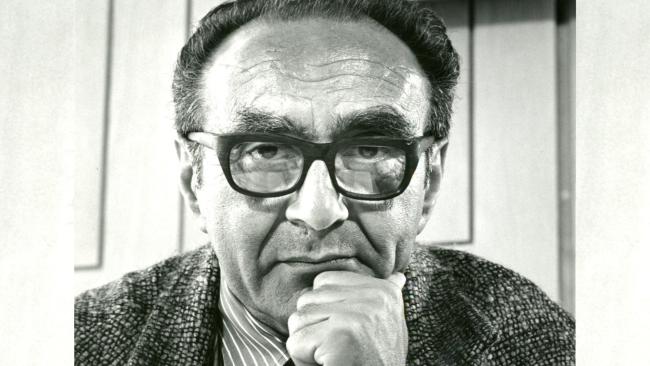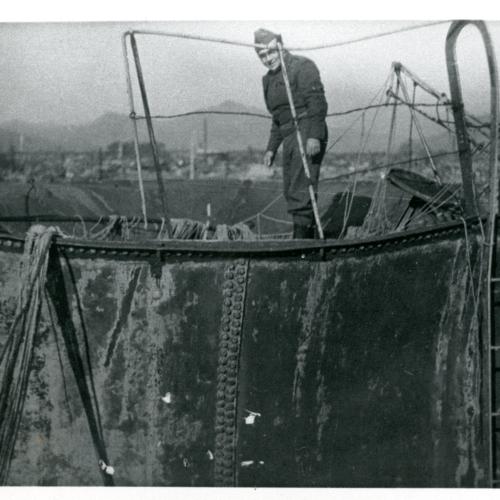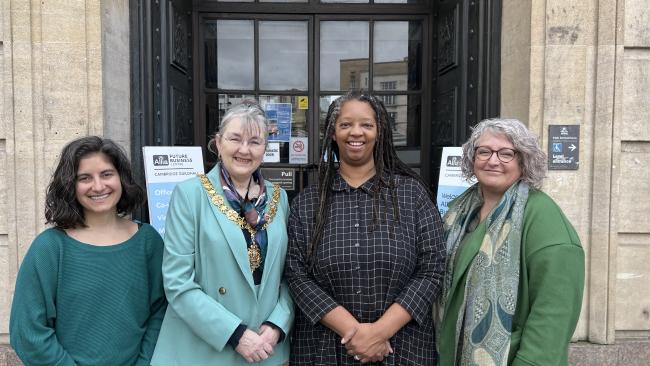
‘The Ascent of Man’ at fifty
5 May 2023 marks the fiftieth anniversary of the first broadcast of the BBCTV series The Ascent of Man. Stephen Moss, a regular independent researcher of the Jacob Bronowski (1927) papers at the Archive at Jesus College since 2018, blogs about this landmark event.
Jacob Bronowski was a mathematician and a poet, an administrator and philosopher, but was best known as a pioneer of science broadcasting. He was most famous for the BBC TV series The Ascent of Man, first broadcast fifty years ago in May this year. His collected papers are held in the archive at Jesus College and includes material relating the development of this landmark series.
"Man is a singular creature. He has a set of gifts which make him unique among the animals: so that, unlike them, he is not a figure in the landscape – he is a shaper of the landscape."
With these words, Bronowski opened the first programme from the La Jolla shores near his home. In thirteen programmes, commissioned by David Attenborough, then Controller of the new BBC2 channel, and broadcast in colour on the new 625-line standard, the series was conceived as a scientific response to Civilisation, a series written and presented by the art historian Kenneth Clark. Both were shown around the world in more than 20 countries and represented a new television documentary form.
The BBC’s first choice for presenter was the immunologist Sir Peter Medawar but in 1969 he suffered a life-changing stroke. Bronowski was second on the shortlist. He was at that moment deputy director of the Salk Institute, a biological research unit in San Diego, and had emigrated to southern California in 1964, leaving a position as director of research for the Coal Board where he had administrated the development of smokeless fuels. The institute had been founded by Jonas Salk, pioneer of the first successful polio vaccine, and was multi-disciplinary across the sciences, and with an eye to the arts. Bronowski held a belief that dialogue between these two cultures was necessary to democracy and had a long-standing ambition to show science as a culture equal to the arts. When Salk called, he was delighted to find that this was exactly what he was expected to do.
To see why he came to be chosen by the BBC to present an ambitious and expensive series, it is necessary to understand some of his personal background.
Bronowski had travelled with his family to Britain from Germany in 1920. He had forgotten every word of his Polish mother tongue but soon learnt English, though it was a scholarship to read maths at Jesus College that took him out of London’s impoverished East End.
Above his rooms on staircase ‘C’ at Jesus College lived Alistair Cooke, with a similarly modest background: he went on to become the US correspondent of the Guardian and wrote ‘Letter from America’ for BBC radio for over fifty years.
At Cambridge, Bronowski wrote poetry heavily influenced by T.S. Eliot, whom he knew, and developed an undergraduate magazine with his friend William Empson that attracted contributors as diverse as Michael Redgrave, yet to take up acting, and Henri Cartier-Bresson who was then a painter and had yet to discover himself as a photographer. Every year, after his Cambridge exams, Bronowski spent time with avant-garde modernist writers in Paris and it was here in 1930 that his friend Samuel Beckett introduced him to James Joyce.
In 1934, after finishing a PhD in algebraic geometry, he accepted an offer to spend time in a writer’s colony in Mallorca with Robert Graves and the American poet Laura Riding. He went there with his girlfriend Elyse Roberts, smoked a pipe, and made fish stews, spending afternoons playing chess in the local cafes. But they found the colony to be elitist, and Laura Riding controlling and overbearing, and besides, they ran out of money. They left after six months, Bronowski to become a maths lecturer at the University of Hull. Roberts was ultimately to found ‘Which’ magazines.
Bronowski might have stayed in Hull had war not intervened and turned his life upside-down as it did for so many others. For a few years he was passed over for wartime work as a mathematician because MI5 thought he was a communist. They had good reason for thinking it – his mother was a communist and his sister had visited Soviet Russia in 1935 – but he’d never joined the party, even if his political sympathies were left leaning. When he eventually got clearance, he was employed in bomb analysis and was part of a team whose work was crucial in planning bombing raids over Germany, and he was sent as an expert to the USA to teach the Americans how to organise daylight bombing raids, which they used in the fire-bombing of Tokyo.
After the war, as an expert on bomb damage, he was sent as part of a team to Japan to analyse the damage to Tokyo, and the effects of the atom bombs used at Hiroshima and Nagasaki. It was a moment of epiphany: he was utterly shocked by what he had found at Nagasaki, the first city that the group visited.
In a letter from November 1945, Bronowski states: 'The ruin is beyond description; I have seen nothing so terrible before; even the little mound of bones where they have burnt the bodies found in the rubble are not an index of it. It is not worse than Tokyo in appearance, of course (except for the tangled steel buildings pushed askew), but in one’s awareness that this happened in seconds, not hours.’
Bronowski tried to convince his colleagues that Nagasaki should be left exactly as it was and that all postwar conferences on disarmament should be held amongst the ruins. 'Alas, my official colleagues thought nothing of my scheme; on the contrary, they pointed out to me that delegates would be uncomfortable in Nagasaki.'
However, the Nagasaki experience was the start of his broadcasting career. In 1946, the BBC were planning to broadcast an atomic test explosion called Operation Crossroads live from the Bikini Atoll in the Pacific but were unsure if the ambitious long-range relay would succeed. They needed something as a filler if it was to fail. Someone gave them Bronowski’s name, and he was asked to provide a radio talk if the radio link was lost, and to his good fortune that is exactly what happened. On 30 June 1946, Bronowski walked into a studio at Broadcasting House and gave a fifteen-minute talk on the Home Service describing the postwar nuclear world. He had ten million listeners, was rebroadcast, and printed in the Listener magazine.
The visit to Japan left a lasting impression on him, that the atomic bomb was evidence that humanity had become supremely powerful, and that the most powerful people on Earth were now scientists. He was not alone in thinking it essential that knowledge of what scientists did should be a component of everyone's education, a following the successful Bikini broadcast, he set about broadcasting about science on radio in his spare time, alongside his main work at the Coal Board. By 1951 he had presented two series on television about what science was and what it could do. He also wrote several radio plays, one of which, The Face of Violence, won the Italia Prize.
In 1956 he became one of the most famous men in Britain when he was asked to appear once a fortnight on a programme called The Brains’ Trust where three or four ‘experts’ were asked to reply to questions sent in by members of the public. He became a star performer on the programme, as a fellow panellist, the writer and teacher Gwyn Thomas, observed:
"The Doctor would wait until the rest of us had, in full mental disarray, yammered out our footling opinions. He would smile and watch us dripping with disgrace. Then he would lay a gigantic wreath of logic on our shallow graves, enumerating our fallacies and his own truths. His thoughts glittered like Cartier's window. He held his hands in front of him, the fingertips touching as if guarding a shrine of golden perceptions."
The Brains’ Trust ended in 1961. He followed it with a series of 13 programmes bridging the arts and the sciences called Insight but mostly left broadcasting behind when he went to California. Interviewed before he left for the USA by John Maddox in a radio series called Frankly Speaking, (7 January 1964) he explained that:
"The intellectual has a very special status in England. He is thought rather comic but rather lovable. He is part of the landscape; you don't have to take him too seriously, but you listen to him with courtesy and attention. England's a country which has the greatest of charms for intellectuals like me: it's a country of Philistines who are enormously tolerant."
In 1969, when the BBC asked him to consider developing a new series for them, he had been working for the Salk Institute for five years. He was invited to lunch with David Attenborough. They sat in a viewing room with the producer Adrian Malone and Aubrey Singer, Head of Features. Malone was lined up as a possible producer for the whole series. They all watched an episode of Civilisation. Immediately after, Bronowski commented that it was very well produced, but that it contained no science. Was science not part of civilisation? That was exactly the response they’d hoped he’d make. He asked to go away and think about the proposition for a month and by the middle of August he had sketched the outline of thirteen programmes. He knew that taking on the project meant he would have to suspend his research, but he missed broadcasting; it did not take much encouragement to convince him to accept the challenge.
Contracts signed, scripts finalised, all research done, Bronowski arranged three years of sabbatical leave from the Salk and the team set off. Over the next eighteen months, they visited 27 countries. It was a hectic schedule. Bronowski was often tired; sometimes he was ill. On one occasion, at Easter Island, Bronowski had a respiratory infection and Malone had to carry him:
"We were up a mountain, and he was quite ill, and I had to carry him - but he was a small man, and I'm fairly large and I carried him like a baby, and it should have been a very moving time... But what Bruno was concerned about was whether we had the right camera angle on him and if the sun was in the right place."
Throughout all filming, Bronowski worked without a script. He was capable of elegant, spontaneous speech in a single take straight to camera, and when the book version of the series was produced little had to be changed; the account had always been complete in his mind.
The scenes filmed at Auschwitz are the most famous of the whole series. It rained incessantly whilst the film crew were there. In a letter, Bronowski describes it as ‘a moving and imaginative museum of understatement without horror and yet without mercy – the heaps of spectacles, artificial limbs, old chamber pots, old toothbrushes, old anything, hair and shoes the Germans stocked in warehouses.’
It was also a place where members of his own family had been killed. Bronowski walked up and down for five minutes, deciding what to say, and stepped into a pond into which had been ‘flushed the ashes’ of those murdered there, the water coming up to his ankles. Bending down, he scooped a handful of ashes from the bottom of the pond. He says to camera:
"Science is a very human form of knowledge. We are always at the brink of the known, we always feel forward for what is to be hoped. Every judgment in science stands on the edge of error and is personal. Science is a tribute to what we can know although we are fallible. In the end the words were said by Oliver Cromwell: ‘I beseech you in the bowels of Christ, think it possible you may be mistaken’. I owe it as a scientist to my friend Leo Szilard, I owe it as a human being to the many members of my family who died at Auschwitz, to stand here by the pond as a survivor and a witness. We have to cure ourselves of the itch for absolute knowledge and power. We have to close the distance between the push-button order and the human act. We have to touch people."
Filming and editing complete, Bronowski went home to California at the end of 1972 to resume the research he had suspended back in 1969. A publicity schedule was organised, beginning in April 1973, but that same month Bronowski suffered a heart attack and was ordered by his doctors to rest completely. The series was shown in May without publicity to support it. Six months later in November, with Bronowski recovered, a new schedule was drawn up, lighter than originally planned, including appearances on Desert Island Discs and Parkinson, the late-night chat show.
During the Parkinson recording the same heart symptoms he had experienced earlier in the year returned and he was taken to a dressing room to recover. He wrote an account of his symptoms into his pocket diary in tiny, spidery handwriting. After half an hour he resumed the recording and went off to a party.
It was during a visit to friends in East Hampton, Long Island, New York in August 1974 that Bronowski had a chance to rest properly, but it was here one morning that he had a second heart attack. This time it was fatal. He was 66.
The Ascent of Man was shown in thirty countries and the series attracted many awards and became the basis of several university courses. His eldest daughter was Lisa Jardine, a graduate of Jesus College and its first female fellow. In a radio interview in 1999 she summed up the achievement of the series:
"I do believe that my father thought that the Ascent of Man was the culmination of his life's work. At the time, that was an unfashionable view to hold, to believe that TV might be a more important memorial than a book, however accessible, but the challenge to produce the rounded intellectual history of mankind was one to which he gave his whole life, and it was the memorial he wished to be remembered by." [Lisa Jardine quoted in BBC Radio 3 Prom interval feature, 28 July 1999]
This article has been written by Stephen Moss and the opinions expressed are those of the author.
![Jacob Bronowski, aged 12-15, with his sister, Lilli [JCPP/Bronowski/12/3/3] Jacob Bronowski, aged 12-15, with his sister, Lilli.](/sites/default/files/styles/max_650x650/public/bronowski_12_3_3_jacob_and_lilli.jpg?itok=GJStGaxf)
![Freshers 1927 [JCCA/JCPH/PHO 6/1/24] Freshers 1927](/sites/default/files/styles/max_650x650/public/freshers_1927.jpg?itok=mH8LhI0f)
![Jacob Bronowski as a Fresher [JCPH/PHO/6/1/24] Jacob Bronowski as a Fresher](/sites/default/files/styles/max_325x325/public/fresher_bronowski_0.jpg?itok=WwvBxIgu)
![Jacob Bronowski as a student at Jesus College, Cambridge [JCPP/Bronowski/12/3/4] Jacob Bronowski as a student at Jesus College, Cambridge](/sites/default/files/styles/person/public/bronowski_12_3_43_0.jpg?itok=f8JRx7q9)
![Songs for Sixpence [JCPP/Bronowski/1/5/1] Songs for Sixpence edited by J. Bronowski and J. M. Reeves](/sites/default/files/styles/max_325x325/public/bronowski_1_5_1_1.jpg?itok=bx_OQ-R1)
![Songs for Sixpence [JCPP/Bronowski/1/5/1] Songs for Sixpence edited by J. Bronowski and J. M. Reeves](/sites/default/files/styles/max_325x325/public/bronowski_1_5_1_2_1.jpg?itok=Qnp0lQwN)
![Songs for Sixpence [JCPP/Bronowski/1/5/1] Songs for Sixpence edited by J. Bronowski and J. M. Reeves](/sites/default/files/styles/max_325x325/public/bronowski_1_5_1_3.jpg?itok=TeuomFRj)
![Songs for Sixpence [JCPP/Bronowski/1/5/1] Songs for Sixpence edited by J. Bronowski and J. M. Reeves](/sites/default/files/styles/article_event/public/bronowski_1_5_1_4.jpg?itok=5EfTnB4C)

![Letter to Rita, Nagasaki, November 1945 [Bronowski/1/1/2/2] Letter to Rita, Nagasaki, November 1945](/sites/default/files/styles/max_325x325/public/bronowski_1_1_2_2_nagasaki_1_november_19451.jpg?itok=ksmMV0ZJ)
![Letter to Rita, Nagasaki, November 1945 [Bronowski/1/1/2/2] Letter to Rita, Nagasaki, November 1945](/sites/default/files/styles/max_325x325/public/bronowski_1_1_2_2_nagasaki_1_november_19452.jpg?itok=F2hgjaA5)
![Letter to Rita, Nagasaki, November 1945 [Bronowski/1/1/2/2] Letter to Rita, Nagasaki, November 1945](/sites/default/files/styles/max_325x325/public/bronowski_1_1_2_2_nagasaki_1_november_19453.jpg?itok=nP_deSBy)
![Letter to Rita, Nagasaki, November 1945 [Bronowski/1/1/2/2] Letter to Rita, Nagasaki, November 1945](/sites/default/files/styles/max_325x325/public/bronowski_1_1_2_2_nagasaki_1_november_19454.jpg?itok=ShuJGwC6)
![Letter to Rita, Nagasaki, November 1945 [Bronowski/1/1/2/2] Letter to Rita, Nagasaki, November 1945](/sites/default/files/styles/max_325x325/public/bronowski_1_1_2_2_nagasaki_1_november_19455.jpg?itok=0MpkVxR8)
![Letter to Rita, Nagasaki, November 1945 [Bronowski/1/1/2/2] Letter to Rita, Nagasaki, November 1945](/sites/default/files/styles/max_325x325/public/bronowski_1_1_2_2_nagasaki_1_november_19456.jpg?itok=hziMUnKb)
![Telegram inviting Bronowski to the Italia Prize Award Ceremony in 1951 [JCPP/Bronowski/1/5/38] Telegram inviting Bronowski to the Italia Prize Award Ceremony in 1951](/sites/default/files/styles/max_650x650/public/bronowski_1_5_38_telegram.jpg?itok=Xs0MY-6v)
![Entry in the programme for the Italia Prize Award Ceremony in 1951 [JCPP/Bronowski/1/5/38] Entry in the programme for the Italia Prize Award Ceremony in 1951](/sites/default/files/styles/max_650x650/public/bronowski_1_5_38_programme.jpg?itok=A4jLycdd)
![Early draft location map for The Ascent of Man [JCPP/Bronowski/6/4/1] Early draft location map for The Ascent of Man](/sites/default/files/styles/max_650x650/public/bronowski_6_4_1.jpg?itok=NPR6MrZ2)
![Letter to Rita, Sunday 23 April 1972 [JCPP/Bronowski/9/1/4] Letter to Rita, Sunday 23 April 1972](/sites/default/files/styles/max_325x325/public/bronowski_9_1_41.jpg?itok=zfg2lXyu)
![Letter to Rita, Sunday 23 April 1972 [JCPP/Bronowski/9/1/4] Letter to Rita, Sunday 23 April 1972](/sites/default/files/styles/max_325x325/public/bronowski_9_1_42.jpg?itok=dmuVfY_4)
![Letter to Rita, Sunday 23 April 1972 [JCPP/Bronowski/9/1/4] Letter to Rita, Sunday 23 April 1972](/sites/default/files/styles/max_325x325/public/bronowski_9_1_43.jpg?itok=fDIw2eul)
![Letter to Rita, Sunday 23 April 1972 [JCPP/Bronowski/9/1/4] Letter to Rita, Sunday 23 April 1972](/sites/default/files/styles/max_325x325/public/bronowski_9_1_44.jpg?itok=qc5Tdhre)
![Letter to Rita, Sunday 23 April 1972 [JCPP/Bronowski/9/1/4] Letter to Rita, Sunday 23 April 1972](/sites/default/files/styles/max_325x325/public/bronowski_9_1_45.jpg?itok=1FUyewIr)
![Letter to Rita, Sunday 23 April 1972 [JCPP/Bronowski/9/1/4] Letter to Rita, Sunday 23 April 1972](/sites/default/files/styles/max_325x325/public/bronowski_9_1_46.jpg?itok=IBr9Ldao)
![Entry in Bronowski's Pocket Diary, November 1973 [JCPP/Bronowski/2/1/45] Entry in Bronowski's Pocket Diary, November 1973](/sites/default/files/bronowski_2_1_45.jpg)





